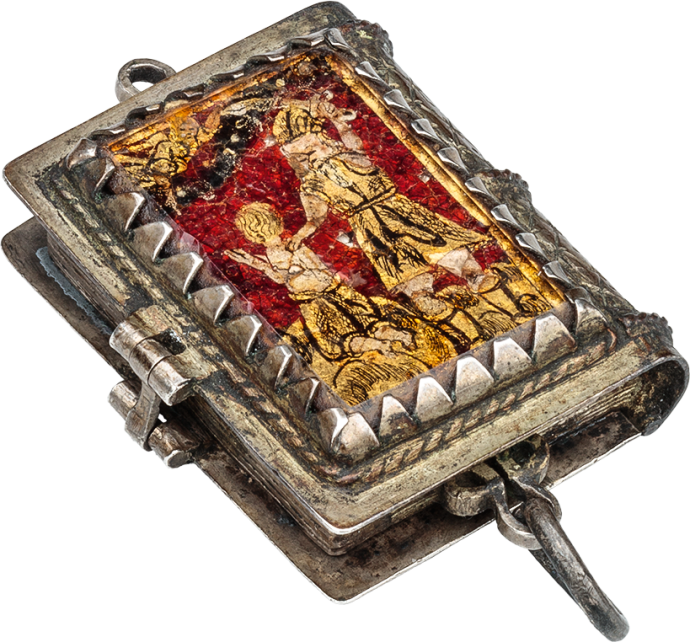


Reliquary Pendant in form of a Book
, 1630–40

Reliquary Pendant in form of a Book
Description
This book may have satisfied the desires of a particular patron, perhaps even one of the Jewish faith. The images that have been chosen for the four verre églomisé inserts are somewhat unusual within the group of comparable objects; on the front is Moses, on the back is the Sacrifice of Isaac. On the inside, instead of an iconic or doctrinal image, one sees portraits of the patron and his wife, in their finest dress, contents reminiscent of a modern locket with photographs of loved ones enclosed. The image of Moses on the front of the book/locket depicts the prophet kneeling before the tablets of the Law and in front of the flaming branches of the burning bush. Moses is speaking with God, gesticulating with a pointing index finger, and looking up to a figure in a bank of clouds above who gestures back. The "horns" that were typical in representations of Moses during this period derived from a mistranslation of the biblical text describing the prophet's head as surrounded by rays of light (Exodus 34:29). Here his figure glows in gold against red, delineated with fine black lines.
The scene of the Sacrifice of Isaac, illustrated on the book’s back cover is, of course, the great biblical demonstration of unquestioning faith. Abraham raises his sword to kill his son as he has been instructed to do by God, while the angel descending from heaven stops the blade just before it can swing down to behead the boy. Inside the book, in contrast to these momentous biblical statements of faith and prayer, we find a very different sort of scene that requires a different sort of looking. Here we are asked to gaze in approval upon a couple, their portraits perhaps included in this object as a commemoration of their marriage. The couple are obviously wealthy, and hold objects and wear clothing that reinforce the perception of their status.
Surely this sort of object, even if it was created in commemoration of a marriage, as were so many double portraits, would have been an especially precious family heirloom. Descendants could treasure it for its religious significance and for its value, and on occasion would have opened it to remember and mourn their deceased ancestors.
Provenance
Collection of Liuba (1923-2005) and Ernesto (1918-2003) Wolf; their sale. Paris, Artcurial, 1 December 2014, lot 86. They were major collectors of modern and tribal art and antiquarian books and donated their collection of Byzantine and medieval glass to the Landesmuseum Württemberg, Stuttgart.